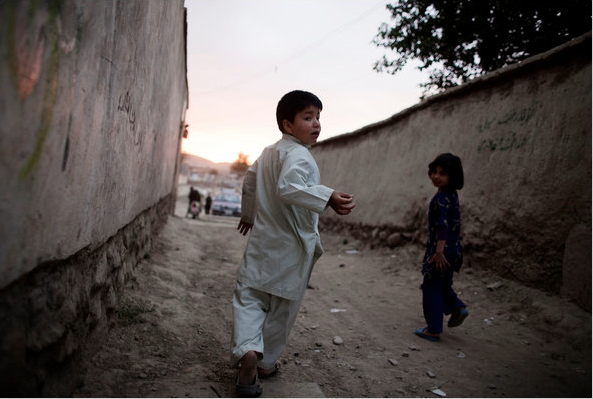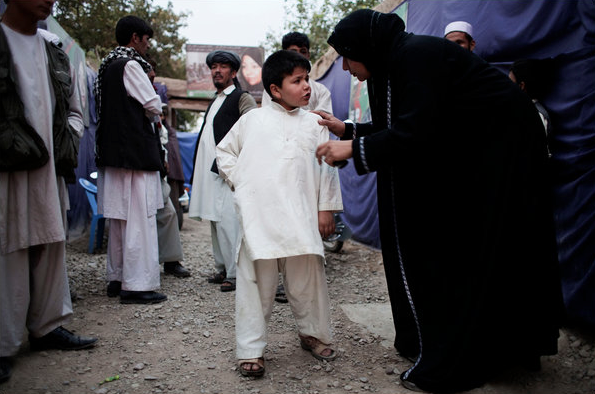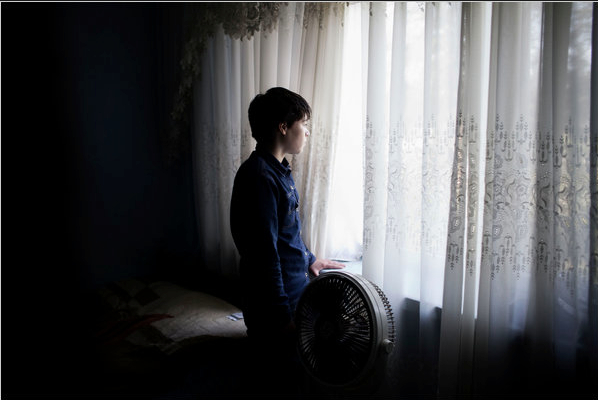By guest correspondent Emily Dianne Cram
Two children in Afghanistan play in an alleyway between two houses. The child on the left awkwardly turns forward while looking back towards the viewer. The child, whose name is Mehran appears to be running toward a place in the distance where bodies blur almost indistinguishably from one another. Or maybe Mehran is running away from the spectator watching the scene unfold. Whether moving towards or away from particular coordinates, the important point to note is that the viewer of the photograph sees Mehran suspended in what appears to be a moment of stasis, yet simultaneously always moving.
Mehran’s story is one of several featured in a recent New York Times essay and slide show that chronicles a practice known as “bacha posh,” in which female-bodied youth pass as boys to secure their families’ status within their communities. The title of the essay—“Afghan Boys are Prized, So Girls Live the Part”—cues the spectator habits the “gender abroad” genre typically evokes: condemnation of a misogynistic practice. Yet, such a judgment seems problematic if we take another look from a perspective that troubles how we think about gender.
What is remarkable about the slide show is the banality of bacha posh in a cultural context Westerners typically see as marked by strict gender segregation. In the image, below, Azita Rafaat, a member of Parliament, leans down to address Mehran, who dresses as a boy.
The entire scene invokes the narrative of a mother attempting to quiet and contain an unruly child in public. Rafaat’s hand curls firmly around Mehran’s shoulder as she demands the child’s attention with what appears to be a stern look. Rafaat reacts with an expression that is in equal parts puzzlement and discontent. What is especially distinctive about the photograph is how Mehran’s white clothes blend into the bodies of the men in the background, while Rafaat, shrouded in black, awkwardly ushers the child through the scene. And what we get is something of an allegory for the often confusing norms of public and private behavior that implicate the equally confusing norms of gender and sexual identity as they manifest in their local contexts. And in the end, Mehran’s particular identity hangs in the balance.
These photographs illustrate how gender in particular is a way of moving one’s way through the world to produce forms of social relationality. Yet, this view is contingent on seeing gender as a permeable category that people use as a means of building their communities. Accordingly, gender is an embodied act, something that is done to produce a relation to others in the world. This perspective enables us to see gender in transition, and how cultural practices often exceed the strict binaries of male/female and woman/man. Perhaps if we take our everyday embodied violations of categories more seriously, we can see the work gender does in a different light, rather than rush to judgments about others.
And yet, the act of seeing gender in transition is imbued with its own paradoxes. In the photograph below Zahra, a girl who has passed as a boy since childhood, gazes pensively through sheer curtains towards a bright, sunlit day.
The juxtaposition between the shadows behind Zahra’s back and the white light greeting “hir”* face and torso suggests that the secret past is coming to an end. Part of bacha posh is a transition into womanhood and the rites of marriage and motherhood. For Zahra and others, such a transition is difficult and at times undesirable because of the way their bodies sediment a particular way of being with others. Another look shows Zahra gazing towards an inevitable future with a sense of heavy dread, and we learn not only of hir desire to live as a boy, but that s/he has never “felt like a girl.”
Zahra’s story shows the contingency of gender, and the heartbreak that emerges when one’s own desires for a particular embodiment conflict with community norms and practices. This tension is endemic to the human condition, one that we all embody as we attempt to find the way our bodies fit into spaces of the world.
* “Hir” is a neutral pronoun that serves as one alternative to the gender binaries embedded in the English language. I choose to use “hir” in this case because of the way Zahra describes hir embodiment: female bodied, yet desiring a male public presentation. “Hir” emerges from a transgender critique of language, a perspective that understands the limits of and inventional potential of language in articulating the complexity of embodiment.
Photo Credit: Adam Ferguson/NYT
Emily Dianne Cram is a PhD student in Rhetoric and Public Culture at Indiana University, and her research engages the intersections of visual culture, embodiment, and gender and sexuality. She can be contacted at emcram@indiana.edu.



Very interesting post. I had seen the 2003 movie “Osama,” about an Afghan girl who disguises herself as a boy, but I did not realize it was a common practice with its own name. What I find odd about “bacha posh” is that the families are doing it to “improve their status in the communities,” as you say. But what happens to this social status when the child’s real gender is revealed? This may be a stretch of a comparison, but it reminds me of a financial Ponzi scheme that starts with a lie and repeats it over and over again until it snowballs out of control. It seems like a good idea in the short run, but inevitably must come crashing down.
How depressing and ultimately defeating that this lesson in the “contingency of gender” has its basis in the undesirability of being or having a girl-child.
Such a great topic for the latest cycle of hip and knowledgeable gender analysis in the blogosphere, but in the end it’s all about how it sucks to be a woman in much of the world.
I find it interesting that “bacha posh” is practiced to secure status in a family. It just goes to show how different societies are. It is disappointing that Westerners look down upon this oppositional looking of gender-bending, so it is captivating to see the opposite in another culture’s context. I believe that the Westerner’s concept of the male or female gaze is disempowering. Zahra has this viewing relationship characteristic of some particular sets of social circumstances. As Zahra is gazing towards an inevitable future, it reminds me of a mirror-image, where one can imagine control over the body in image, but cannot actually physically exert that control. It also provides this splitting between what they are physically capable of and what they see and imagine themselves to be. I do not feel gender should be involved in the identity category as well as masculinity/femininity. But still, the Western emphasis on postmodernism on the concept of multiple subjectivities is the product of our social relations to social institutions; and identity politics is the fundamental question of cultural difference.